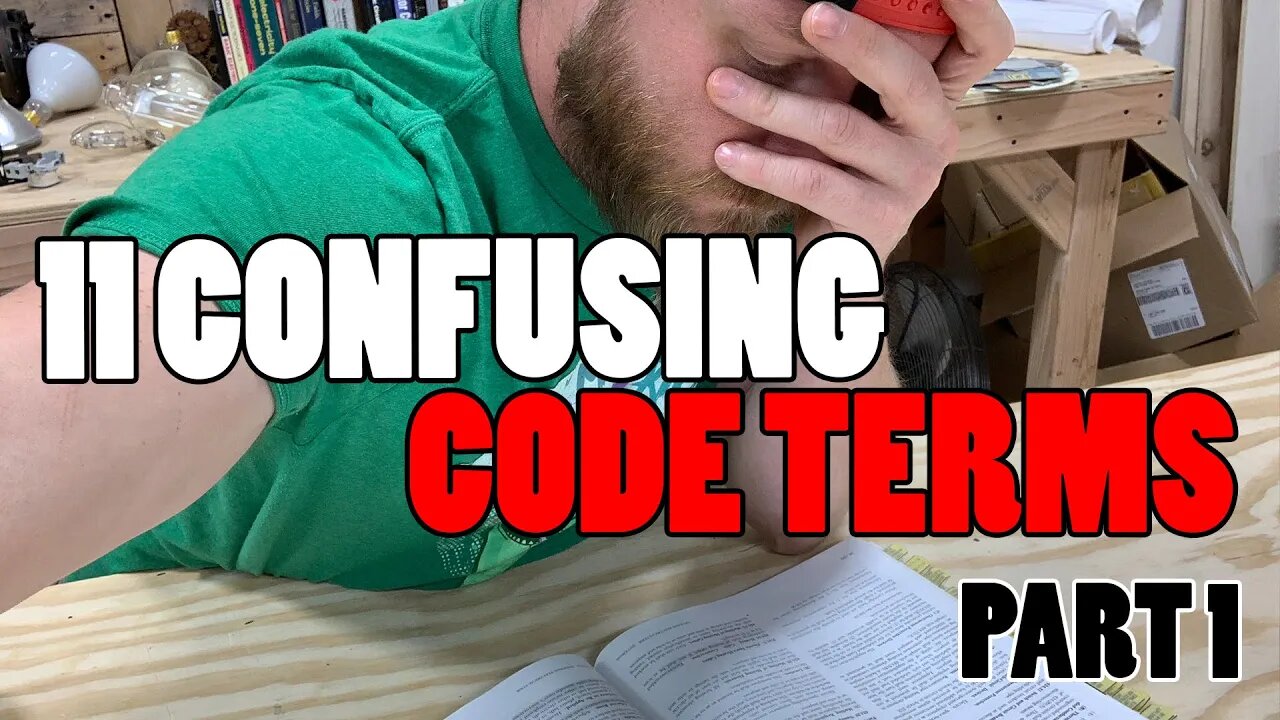Premium Only Content

Episode 38 - 11 Confusing Code Terms - UNDERSTANDING THE NEC
Let’s face it…the national electric codebook is probably the most difficult construction document to read and understand. It’s written like a court document in legalese, using terms none of us use in the field, for the sake of liability and C.Y.A. These are 11 terms that are used in the NEC that I feel people struggle with understanding when they first buy a code book.
👾🤖PRACTICE EXAMS🤖👾
https://www.electricianu.com/practice-exams
😎👕MERCH👕😎
https://www.electricianu.com/merchandise
📲👥SOCIALS👥📲
Instagram - https://www.instagram.com/electrician_u
Discord - https://discord.gg/7ykYfbh
Facebook Page - https://www.facebook.com/theelectricianu
Facebook Group - https://bit.ly/2tz7eQh
TikTok - https://www.tiktok.com/@electricianu
#1 - UNGROUNDED CONDUCTOR
Ungrounded conductors are the “hot” wires we deal with. They’re normally the phase conductors that people think of as black. They’re called ungrounded, because they are the conductors what we DO NOT want to every be grounded - intentionally or unintentionally. We want them supplying power to a load, not supplying power to metal surfaces or to the earth - so they’re different than GROUNDED conductors.
#2 - GROUNDED CONDUCTOR
Grounded conductors are the exact opposite of ungrounded conductors. Grounded conductors are what we in the field call a “neutral.” This is the white wire in a 120v circuit (US). The reason this is called the grounded conductor is that in the transformer where power is being derived, there is a coil (there may be several) of wire. One end of this wire is one of our hots (ungrounded conductor), and the other side of that same coil of wire is where our other phase comes from. So we get L1 and L2 (240-volts) from one piece of wire shaped into a coil. Well when you take the mid-point of that coil and bolt another conductor to it, that middle point is what we call the NEUTRAL POINT. We can hook a conductor to this and bring it down to the earth to ground it. So now we have a responsible reference for stable voltage, and have mechanically attached it to the earth so the earth is at the same potential. This also provides us with a half-voltage between L1 and L2’s 240-volts - so we can have 120-volt circuits as well.
#3 - EQUIPMENT GROUNDING CONDUCTOR
Equipment grounding conductors are the conductors that connect the metal housing of equipment back to to the neutral (grounded conductor) at the service. This is the, typically green or bare conductor (US systems) that we call out in the field…the ground. These conductors are sized based off of the breaker ahead of the equipment and need to be run in a way to ensure a low-impedance path for fault-current to take in case something bad happens in an electrical circuit.
#4 - GROUND-FAULT
A ground fault is an accident, we’ll just start with that. It’s when an ungrounded conductor (hot) comes into contact with a piece of metal. This piece of metal will become energized if it is not intentionally grounded. The reason we ground the metal enclosure of equipment is so that if this happens, that equipment doesn’t just sit there energized while someone walks up, touches it, and gets shocked. If we ground the equipment, it allows the current to return to the neutral, completing a circuit which assists in tripping the breaker for that circuit. I cannot express enough, the importance of proper grounding and bonding. A lot of electricians don’t understand the dire importance of ground-fault protection.
#5 - GROUND-FAULT CIRCUIT-INTERRUPTER (GFCI)
This is an easy one to grasp, especially if you read the paragraph above. A GFCI device is a special device designed to disconnect the incoming line-side conductors from the load-side conductors going out to a piece of equipment - WHEN there is a ground fault. They do a very good job of detecting faults to ground and help save lives and equipment.
#6 - ARC-FAULT
Arc-faults differ from ground-faults in a key way. They’re still “accidents” that should be prevented, but rather than having a solid connection between an ungrounded conductor and a grounding conductor an arc-fault is a literal arc between two things that should not have an arc between them. This could be a loose termination, an air gap between something, a damaged conductor or piece of equipment, etc. There are a lot of reasons that arcs occur, but they’re very dangerous and cause many fires every year. They can ignite fibers and gasses, they can heat up to a point of insulation-breakdown and cause a short, and much more. Series arc-faults occur between two points on a circuit that are in series with one another. Parallel arc-faults are between two circuit conductors such as “line to line,” “line to neutral,” or “line to ground.”
#nec #electriccode #electrical
--
Subscribe - https://www.youtube.com/c/electricianu?sub_confirmation=1
IF YOU ENJOY THESE VIDEOS PLEASE SUBSCRIBE AND OBLITERATE THAT "LIKE" BUTTON
-
 0:58
0:58
Electrician U
1 year agoFISH STICKS! Every electrician needs these!
6.33K -
 LIVE
LIVE
SpartakusLIVE
3 hours agoSpart Flintstone brings PREHISTORIC DOMINION to REDSEC
240 watching -
 1:05:02
1:05:02
BonginoReport
6 hours agoKamala CALLED OUT for “World Class” Deflection - Nightly Scroll w/ Hayley Caronia (Ep.167)
95.9K60 -
 54:36
54:36
MattMorseTV
3 hours ago $17.15 earned🔴The Democrats just SEALED their FATE.🔴
27.7K46 -
 8:07:01
8:07:01
Dr Disrespect
11 hours ago🔴LIVE - DR DISRESPECT - ARC RAIDERS - SOLO RAIDING THE GALAXY
104K11 -
 1:32:00
1:32:00
Kim Iversen
6 hours agoThe World’s Most “Moral” Army — Kills 40 Kids During "Ceasefire" | Socialism's Coming: The Zohran Mamdani Agenda
79.2K135 -
 1:04:50
1:04:50
TheCrucible
5 hours agoThe Extravaganza! EP: 63 with Guest Co-Host: Rob Noerr (10/30/25)
72K6 -
 LIVE
LIVE
GritsGG
5 hours agoQuads! #1 Most Wins 3880+!
90 watching -
 2:51:31
2:51:31
Spartan
5 hours agoFirst playthrough of First Berserker Khazan
19.4K -
 5:48:29
5:48:29
The Rabble Wrangler
19 hours agoBattlefield 6 - RedSec with The Best in the West
22.7K